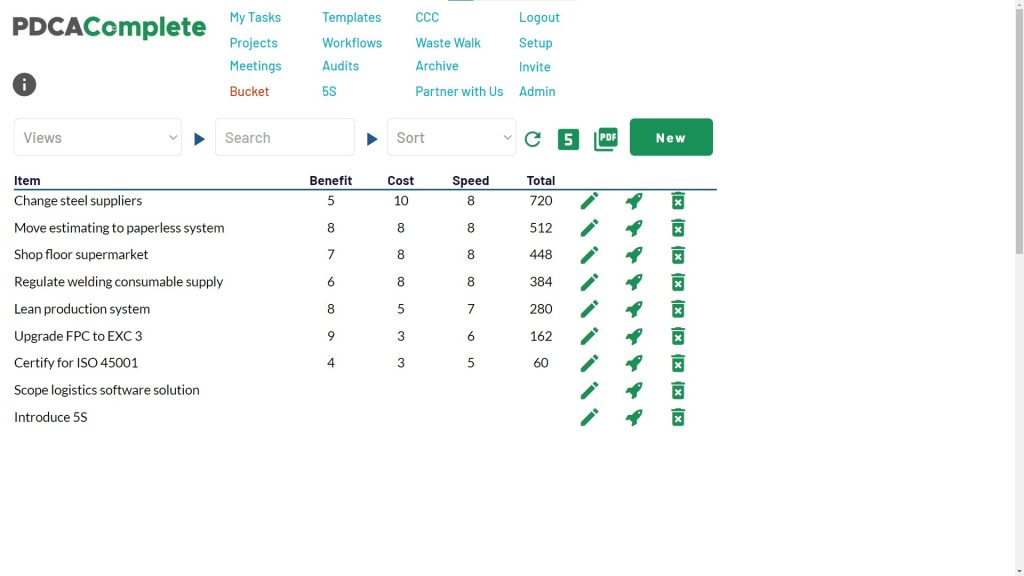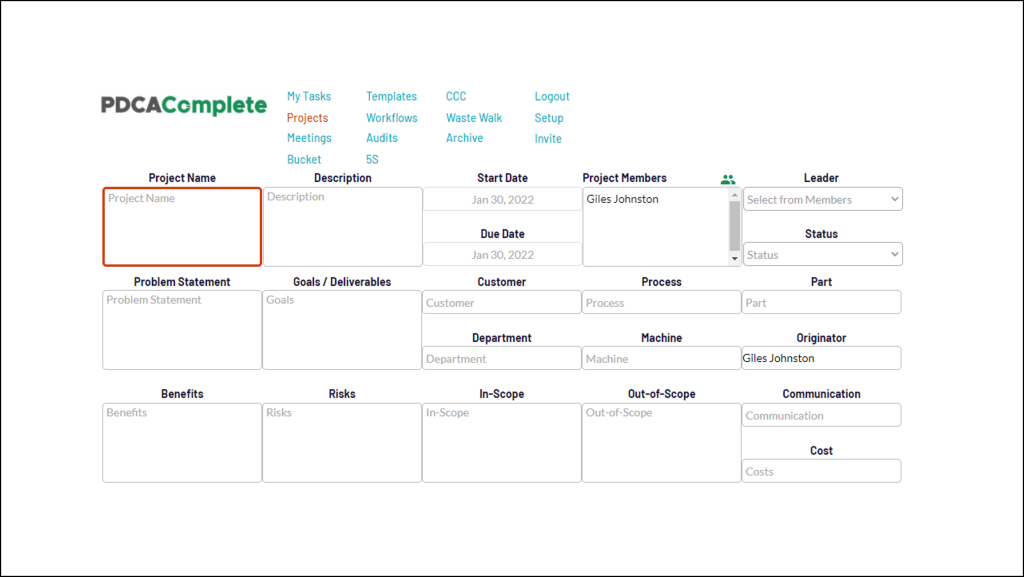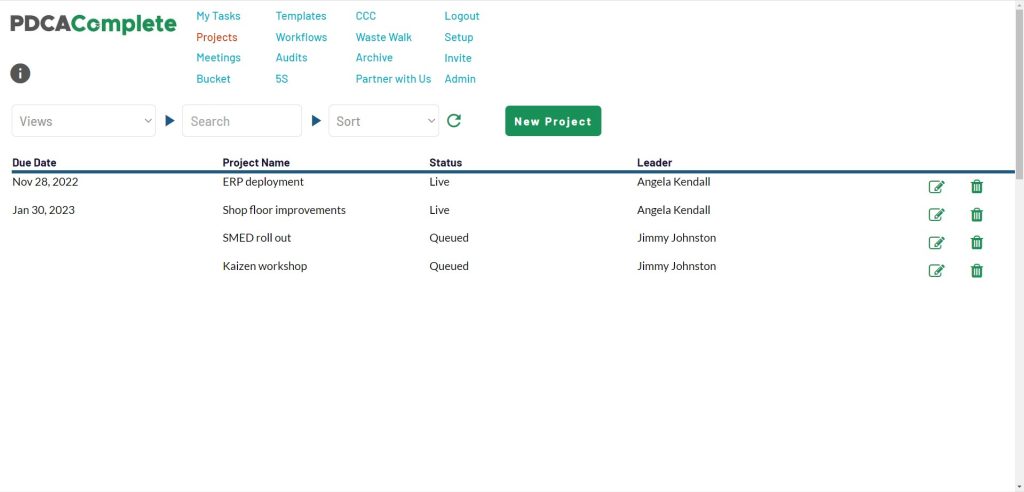This is a challenge we all face at some point. You have too many projects that need delivering at once… What do you do?
In this article I am going to share three strategies that you can consider. I’ll also share with you some ideas on how PDCA Complete can help you with this challenge.
Let’s dive into the first strategy!
Strategy 1: One at a time
This might seem like a luxury but there is a lot of evidence to back up this idea. If you have read any of the Scrum literature you will know that this is often the preferred route.
Maximize focus and deliver each project one at a time. This approach, of course, requires you to prioritize in an effective manner. This is very much where PDCA Complete can come in to help you.
In our Bucket module we have a prioritization system called BCS. This stands for Benefits, Cost and Speed. It is a rating system that allows you to quickly evaluate the impact of each project on your business.

When it comes time to launch a new project, the next highest BCS score gets launched. It doesn’t have to be more complex than this. The key, if you use this strategy, is saying ‘not yet’ to new projects and managing the queue.
Strategy 2: EPE method
EPE is a term borrowed from Lean Manufacturing. In Lean it stands for Every Product Every…’. Its aim is to ensure that you deliver different products in the same time period. It requires the ability to switch efficiently from one product to the next. We can apply this thinking to projects in a similar way.
I am going to split this strategy up further, into two flavours of EPE.
Strategy 2a: EPE week
To utilize this strategy, you will need to segment your working week up. The intention is that you touch all your projects every week.
How you determine how much time you spend on your projects is up to you. Options to do this include:
- Estimate the work content (in hours) divided by the number weeks you have to do the project. This should give you the size of the slots you need in your diary.
- Split up the time you can make available based on the priority of each project. Think pie chart.
- Allocate equal time and gauge progress on a weekly basis and re-allocate based on demand and progress.
Strategy 2b: EPE month
This variation on the theme needs you to create phases for your projects. Each phase needs to have the same amount of work content as you can allocate to projects on a weekly basis.
Each week you move to another project and spin each ‘plate’ once per month. Of course, if you have more, or fewer, than four projects you can be flexible with the length of a week(!).
This approach works best if you can tie a deliverable in with each phase of the project. It also requires effort to ensure that when you come back to the project you know where to pick up from. Wasting time trying to understand the project is a waste of time.
In PDCA Complete we utilize a PID (Project Initiation Document) approach to make deliverables clear. This approach requires a little effort upfront but can speed up the project overall. When used with an EPE approach, this level of clarity makes the approach workable.

If you used phases on your projects, our live and queued project statuses make this very manageable.
Strategy 3: Hybrid
Another option you can consider if having a priority project to focus on and a backup. You direct all effort to your primary project and push it as hard as you can. If you find that your project gets delayed (waiting for decisions etc…) then you drop on to your secondary project.
When your delay / pause on your primary project resolves, you move back to your primary project. Parking your secondary project is essential at this point. When you complete your primary project you promote your secondary project and choose a new secondary project.
PDCA Complete’s project statuses are useful here again. Identifying the two projects you want to rotate is easy this way.

Avoiding re-work
An essential point I need to make clear here is that you need to avoid rework. Going back and fixing mistakes you made during the project are costly. The knock on effect of delivery dates slipping is also something you want to avoid.
Don’t mark a phase or project complete until you have signed the deliverables off. Picking up the thread of your project also needs to be swift so that you don’t waste valuable time. Using the PID approach, as mentioned earlier, should help you avoid this situation.
What fits you best?
If you have the luxury of being able to park projects until later, the first strategy is likely to be a better fit. If you aren’t able to do that, one of the other three options is likely to be a better fit.
I’m sure that you can create a variant that will suit your preferred way of working. Whichever route you take, let me offer two further items to consider:
- If you review the work content, you may be able to re-engineer the tasks. Look for better results for less effort and see if you can remove time from your projects.
- If there is procrastination taking place, remember the Kaizen method. Break down project tasks into very small chunks. Nibble at these chunks and let confidence grow. If you have too many plates to spin, procrastination is often lurking in the wings!
Management review activity
The approach you take may change over time. As with all management responsibilities you need to look at your project list on a regular basis. As priorities change you can adjust your approach and keep your project list up to date.
PDCA Complete has a simple filter system on its project register. Using this can spark the right conversations, to keep you and your team effective.
Free account
If you haven’t already got your free PDCA Complete account then you can sign up today. Our free account is for up to three users and lets you use the bulk of its functionality. You can sign up here to get started.
If you have more than two colleagues, you can upgrade to our paid subscription. The price is dependant on the number of colleagues you want to invite. You can view our pricing page here.
PDCA Complete can help you to save a huge amount of time, making an easy payback. Allocating, updating and progressing project tasks is simpler when you use PDCA Complete.
I hope this article has given you some food for thought. Juggling multiple demands at once seems to be the norm nowadays. If you find yourself dropping the ball from time to time, please give one of the above strategies a go.
